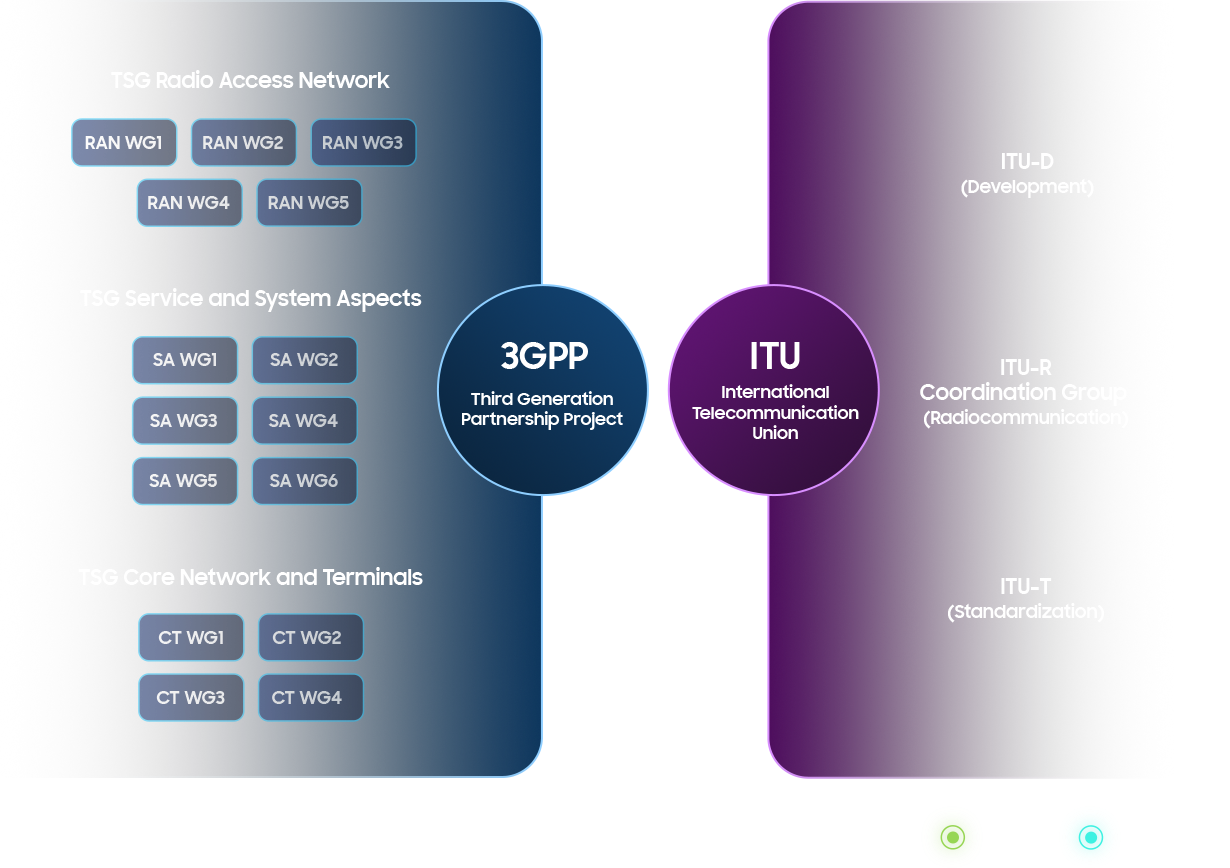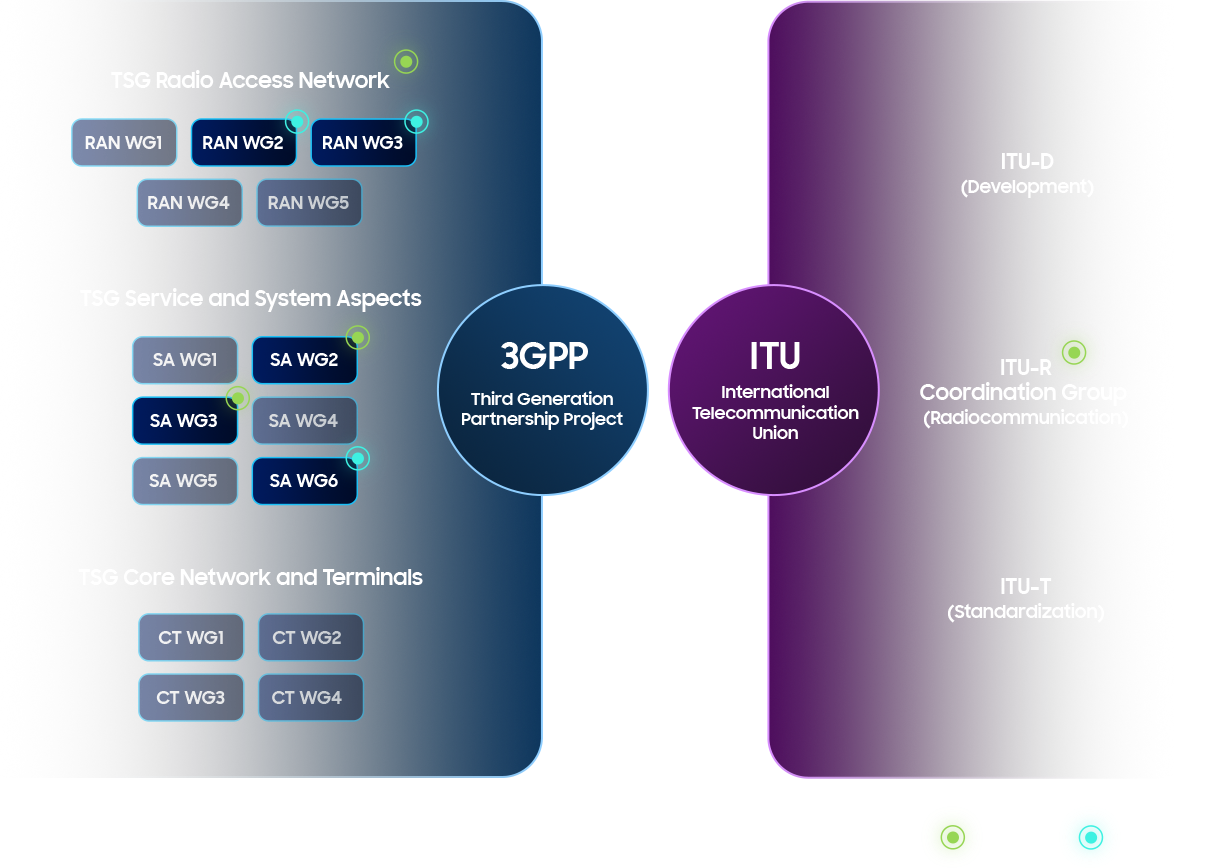6G
Samsung 6G,
Unlocking Infinite Possibilities
Mobile communication systems have evolved from generation to
generation, approximately every 10 years, with the goal of unlocking
enhanced functionality and performance. Each generation has offered
innovative new services ranging from 1G analog voice call services to
4G mobile broadband services. In the late 2010s, 5G was introduced to
provide massive broadband capacity and expand its range of services
into vertical industries. We expect 6G innovations will transform both
societies and industries,
revolutionizing how humans and machines interact.
Shaping the
future with 6G
6G represents more than just an evolution in communication technology—it serves as a catalyst for enabling groundbreaking services across diverse industries and everyday life. The core services of the 6G era will create new value through immersive experiences, digital transformation and hyper-connectivity, with AI further enhancing these capabilities. These services will open up possibilities beyond existing limits in all industries spanning entertainment, healthcare, education, manufacturing and more. By leveraging ultra-high speed, ultra-low latency, and hyper-connectivity, 6G will break barriers between the physical and virtual worlds, offering users even more multi-sensory experiences.
Key emerging services in the 6G era
Immersive Extended
Reality (XR)
Offers truly immersive user experiences by integrating the virtual and real worlds, attracting attention across industries such as entertainment, healthcare and science.
Digital Twin
Creates virtual replicas of physical entities — including objects, people, devices, and places — using 6G & AI technology to allow remote monitoring, problem detection, and control.
Massive Communication
connecting numerous sensors, machines,
and other devices
Ensures personalized service quality and stability even in large-scale connectivity scenarios and supports automation and management of smart cities, homes, and factories.
Ubiquitous
Connectivity
Expands service areas by extending terrestrial network coverage and interworking between terrestrial and non-terrestrial network components — including satellites and high-altitude platform stations (HAPS).
Fixed Wireless
Access (FWA)
Allows wireless delivery of broadband services that traditionally required wired connections to become recognized as a key driver of expanding telecommunications businesses.
The Smart and
sustainable path to 6G
To derive real value from 6G for both end-users and network operators,
it will be of the utmost importance to pursue future-proof and
sustainable user experiences. Samsung expects a paradigm shift towards
AI-native and sustainable communication in the 6G era.
With 6G, AI is expected to be a key technology for improving
operational efficiency, reducing costs, and enhancing overall
performance. As softwarization and virtualization continue to gain
momentum in wireless networks, AI will be a differentiator in
operators’ services and technologies. Furthermore, 6G networks will be
designed with AI capabilities embedded into their architecture and
computing functions—a concept known as ‘AI-native’. Sustainability,
ubiquitous coverage, and secure and resilient networks will also
dominate 6G developments, ensuring long-term viability and global
accessibility.


AI-native communication
Incorporates the latest AI technologies into communication functionalities from system design to the development, management, and operation of systems for performance improvements.
Sustainable network
Reduces operational costs and increases user satisfaction by improving the energy efficiency of both networks and terminals, contributing to operational expenditure (OPEX) savings.
Ubiquitous coverage
Decreases capital expenditures (CAPEX) of networks and enhances service quality by expanding communication service areas and strengthening connectivity via interconnecting terrestrial and non-terrestrial networks.
Secure and resilient network
Ensures network security, user privacy, and resilience for significant advancements in computing capabilities and AI technology for the future.
AI-native &
sustainable
communication
Future-proof and
sustainable user experience
Actively building
6G standardization
Countries and companies around the world are driving discussions about next-generation communications standards, each taking on specific roles. This process demands forward-looking leadership capable of steering technological development and harmonizing diverse viewpoints. Samsung has emerged as a leading entity, simultaneously advancing innovation while building industry consensus. Samsung chaired the International Telecommunication Union - Radiocommunication’s (ITU-R) 6G Vision Group, helping to establish the initial global vision for 6G and contributing to its early roadmap. Samsung also leads discussions within 3GPP by serving as chairs and vice-chairs across various technical groups, steering the direction of standardization. Currently, Samsung Electronics holds a total of six chair and vice-chair positions across 3GPP’s key Technical Specification Groups (TSGs). In particular, the Radio Access Network (RAN) and Systemic Architecture (SA) WG2 and WG3 groups, where Samsung serves as chair, are central to shaping the structure and direction of 6G technologies. Samsung’s representation and presence in these groups underscore our influence in shaping the future of communication technologies.






-
![[Video] Unlock the Infinite Possibilities with Samsung 6G](//images.samsung.com/is/image/samsung/assets/global/business/networks/solutions/6g/content_01.png)
[Video] Unlock the Infinite Possibilities with Samsung 6G
-
![[Whitepaper] AI-Native & Sustainable Communication](//images.samsung.com/is/image/samsung/assets/global/business/networks/solutions/6g/content_02.png)
[Whitepaper] AI-Native & Sustainable Communication
-
![[Whitepaper] The Next Hyper-connected Experience for All](//images.samsung.com/is/image/samsung/assets/global/business/networks/solutions/6g/content_03.jpg)
[Whitepaper] The Next Hyper-connected Experience for All
-
![[PR] Samsung Researcher To Lead 6G Spectrum Discussions in Asia-Pacific Region](//images.samsung.com/is/image/samsung/assets/global/business/networks/solutions/6g/content_04.png)
[PR] Samsung Researcher To Lead 6G Spectrum Discussions in Asia-Pacific Region
-
![[PR] [Next-Generation Communications Leadership Interview ①] ‘Standardization Shapes the Future of Communications’](//images.samsung.com/is/image/samsung/assets/global/business/networks/solutions/6g/content_05.png)
[PR] [Next-Generation Communications Leadership Interview ①] ‘Standardization Shapes the Future of Communications’
-
![[PR] Samsung Electronics Secures Two Leadership Positions in 3GPP](//images.samsung.com/is/image/samsung/assets/global/business/networks/solutions/6g/content_06.png)
[PR] Samsung Electronics Secures Two Leadership Positions in 3GPP
-
![[PR] Samsung Electronics and KT Corporation Collaborate on 6G Research To Improve Signal Quality](//images.samsung.com/is/image/samsung/assets/global/business/networks/solutions/6g/content_07.png)
[PR] Samsung Electronics and KT Corporation Collaborate on 6G Research To Improve Signal Quality
-
![[PR] Samsung Secures a Leadership Position at 3GPP](//images.samsung.com/is/image/samsung/assets/global/business/networks/solutions/6g/content_08.png)
[PR] Samsung Secures a Leadership Position at 3GPP
-
![[PR] Samsung Electronics and KDDI Research To Advance AI Technologies in Future Wireless Telecommunications](//images.samsung.com/is/image/samsung/assets/global/business/networks/solutions/6g/content_09.png)
[PR] Samsung Electronics and KDDI Research To Advance AI Technologies in Future Wireless Telecommunications
![[Video] Unlock the Infinite Possibilities with Samsung 6G](http://images.samsung.com/is/image/samsung/assets/global/business/networks/solutions/6g/content_01.png)
![[Whitepaper] AI-Native & Sustainable Communication](http://images.samsung.com/is/image/samsung/assets/global/business/networks/solutions/6g/content_02.png)
![[Whitepaper] The Next Hyper-connected Experience for All](http://images.samsung.com/is/image/samsung/assets/global/business/networks/solutions/6g/content_03.jpg)
![[PR] Samsung Researcher To Lead 6G Spectrum Discussions in Asia-Pacific Region](http://images.samsung.com/is/image/samsung/assets/global/business/networks/solutions/6g/content_04.png)
![[PR] [Next-Generation Communications Leadership Interview ①] ‘Standardization Shapes the Future of Communications’](http://images.samsung.com/is/image/samsung/assets/global/business/networks/solutions/6g/content_05.png)
![[PR] Samsung Electronics Secures Two Leadership Positions in 3GPP](http://images.samsung.com/is/image/samsung/assets/global/business/networks/solutions/6g/content_06.png)
![[PR] Samsung Electronics and KT Corporation Collaborate on 6G Research To Improve Signal Quality](http://images.samsung.com/is/image/samsung/assets/global/business/networks/solutions/6g/content_07.png)
![[PR] Samsung Secures a Leadership Position at 3GPP](http://images.samsung.com/is/image/samsung/assets/global/business/networks/solutions/6g/content_08.png)
![[PR] Samsung Electronics and KDDI Research To Advance AI Technologies in Future Wireless Telecommunications](http://images.samsung.com/is/image/samsung/assets/global/business/networks/solutions/6g/content_09.png)
